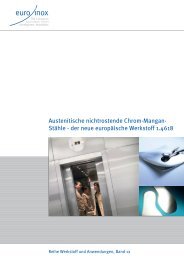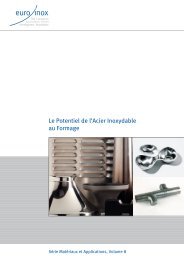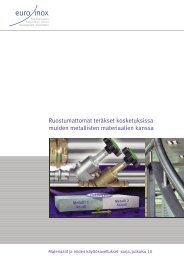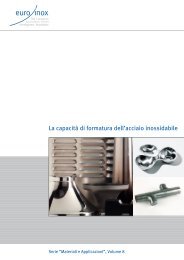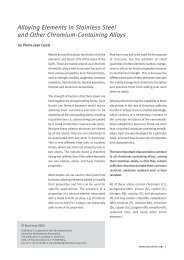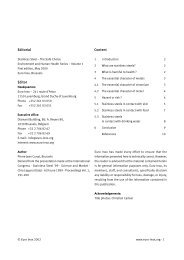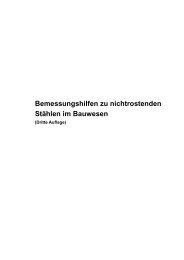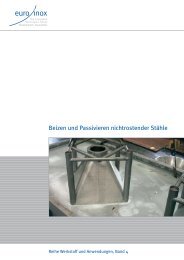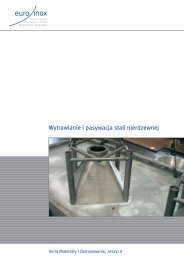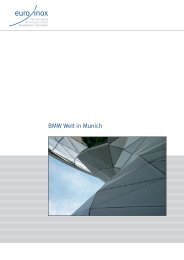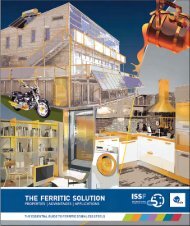Innovative Stainless Steel Applications in transport ... - Euro Inox
Innovative Stainless Steel Applications in transport ... - Euro Inox
Innovative Stainless Steel Applications in transport ... - Euro Inox
You also want an ePaper? Increase the reach of your titles
YUMPU automatically turns print PDFs into web optimized ePapers that Google loves.
There are three basic variants of resistance weld<strong>in</strong>g: resistance spot, projection and<br />
seam weld<strong>in</strong>g. In spot weld<strong>in</strong>g, the electrodes are typically rod-shaped round bars that<br />
produce round, molten “nuggets”, that jo<strong>in</strong> the materials together. In projection weld<strong>in</strong>g,<br />
projections, embossments or other raised features on one of the workpieces def<strong>in</strong>e the<br />
f<strong>in</strong>al jo<strong>in</strong>t-location and area. With this technique, the electrodes have a large contact<br />
surface with the workpiece and the projections ensure that the current is concentrated <strong>in</strong><br />
a small, controlled area. This process can be used to make multiple weld spots <strong>in</strong> one<br />
go, or it can be used for non-flat or complex shapes. In seam weld<strong>in</strong>g, the electrode is a<br />
rotat<strong>in</strong>g disk that produces a series of <strong>in</strong>dividual but overlapp<strong>in</strong>g spot welds, us<strong>in</strong>g<br />
current puls<strong>in</strong>g. This results <strong>in</strong> an apparently cont<strong>in</strong>uous, leak-tight weld seam. A<br />
typical application area for all these resistance-weld<strong>in</strong>g processes is the lap jo<strong>in</strong><strong>in</strong>g of<br />
th<strong>in</strong> sheets of up to about 3 mm thick.<br />
4.3.4 Adhesive bond<strong>in</strong>g<br />
Unlike fusion processes, where bond<strong>in</strong>g and jo<strong>in</strong>t formation is based on melt<strong>in</strong>g and the<br />
result<strong>in</strong>g metallurgical mix<strong>in</strong>g or even reactions, adhesive bond<strong>in</strong>g relies only on<br />
secondary atomic forces – i.e. van der Waals forces at molecular level, formed between<br />
the base material and the adhesive on each <strong>in</strong>dividual surface of the jo<strong>in</strong>t. S<strong>in</strong>ce these<br />
secondary forces are much weaker than a metallurgical bond, the jo<strong>in</strong>t area required for<br />
a given load-bear<strong>in</strong>g capability is usually much larger than <strong>in</strong> a fusion weld. In practice,<br />
this means that <strong>in</strong>stead of the butt or fillet jo<strong>in</strong>ts typical of fusion weld<strong>in</strong>g, adhesive<br />
jo<strong>in</strong>ts are usually lap jo<strong>in</strong>ts, where one flat surface overlaps the other and the<br />
overlapp<strong>in</strong>g area is dimensioned accord<strong>in</strong>g to the required strength properties.<br />
S<strong>in</strong>ce the base materials rema<strong>in</strong> <strong>in</strong> solid state and adhesive bond<strong>in</strong>g is carried out at or<br />
close to room temperature, no distortions related to melt<strong>in</strong>g-resolidification or even to<br />
thermal expansion occur. In addition, any surface coat<strong>in</strong>gs usually rema<strong>in</strong> <strong>in</strong>tact dur<strong>in</strong>g<br />
bond<strong>in</strong>g. There is a vast variety of commercially available adhesives for various<br />
metallic materials and their comb<strong>in</strong>ations, load<strong>in</strong>g and service conditions, process<strong>in</strong>g<br />
routes, etc.<br />
Weldbond<strong>in</strong>g<br />
Adhesive bond<strong>in</strong>g is <strong>in</strong>creas<strong>in</strong>gly used <strong>in</strong> comb<strong>in</strong>ation with resistance spot weld<strong>in</strong>g,<br />
especially <strong>in</strong> the automotive and <strong>transport</strong>-vehicle <strong>in</strong>dustries. Once the adhesive has<br />
been applied between the jo<strong>in</strong>t surfaces, the component is welded us<strong>in</strong>g conventional<br />
spot weld<strong>in</strong>g equipment. The result<strong>in</strong>g jo<strong>in</strong>t usually shows better mechanical properties<br />
than either an adhesive-bonded or spot-welded jo<strong>in</strong>t alone and the adhesive seals the<br />
crevice between the base materials, thus elim<strong>in</strong>at<strong>in</strong>g the risk of crevice corrosion <strong>in</strong><br />
long-term use. The spot welds also have the advangtage of fix<strong>in</strong>g the parts to be jo<strong>in</strong>ed<br />
dur<strong>in</strong>g the sett<strong>in</strong>g of the adhesive.<br />
87



